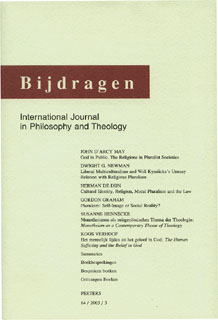 previous article in this issue previous article in this issue | next article in this issue  |

|
Document Details : Title: Vatikanum II Revisited Subtitle: Kontext und Entstehung der Aussage über die 'Hierarchie' der Wahrheiten Author(s): WITTE, Henk Journal: Bijdragen Volume: 68 Issue: 4 Date: 2007 Pages: 445-477 DOI: 10.2143/BIJ.68.4.2023987 Abstract : The principle of the ‘hierarchy’ of truths is ecumenically and catechetically relevant. The Second Vatican Council mentions this principle in the Decree on Ecumenism No. 11. This articles examines the structural and thematic context of the statement on the ‘hierarchy’ of truths and its genesis, especially some contributions to which is paid lesser or no attention in the sketch of the conciliar genesis until now, in order to disclose its ecumenical and catechetical relevance. It appears to be important to situate the statement in the context of the investigative conciliar concept of ‘dialogue with out brothers’, in which the difference between the articulated doctrine and the discerned mystery is respected. Concerning the history of the statement, a letter of titulary bishop S. Ferraz and an only written proposal of abbot J. Hoeck OSB enrich the picture of its genesis and impact that is usually based on the important intervention of Archbishop Pangrazio and on modus 45, an initiative of Cardinal König. The principle of the ‘hierarchy’ of truths is ecumenically relevant as a hermeneutical principle in comparing doctrines in dialogue and catechetically in constructing catechetical material. The christological-trinitarian mystery is to be considered as its centre and core. A still insufficiently answered question concerns the balance between the centrality vs. marginality of doctrines and the universality vs. particularity of the ecclesiastical subject that put them into words. |
